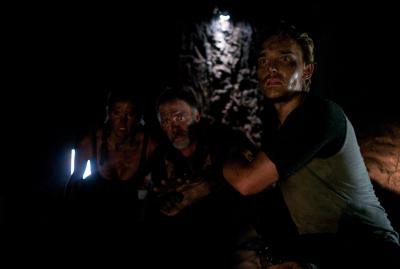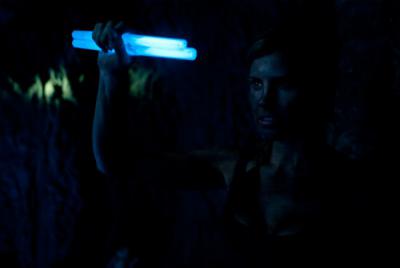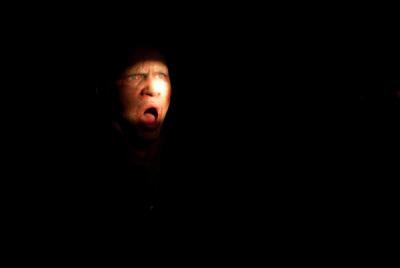By: debbie lynn elias
Coal mining was the bread and butter for much of the Appalachian region of the United States for centuries. Fraught with the inherent dangers of being miles below the earth’s surface in an unknown environment at the mercy of shifting tectonic plates, inhaling dirt and dust with every breath, knowing and fearing that a cave-in could come at any moment, coal mining and mines are almost custom made for the horror genre. Dank, dark and dangerous, the ambient nature alone fuels fear within the recesses of imagination. So it comes as no surprise to find director Ben Ketai taking advantage of those very elements with BENEATH.

Co-written by Patrick Doody and Chris Valenziano, BENEATH is the story of a group of miners trapped beneath the surface when a drilling mis-step causes the mine to collapse on them. As if the prospect isn’t frightening enough for the miners themselves, thrown into the mix is environmental lawyer Samantha Marsh who is in the mine trying to get closer to and understand her father, George, from whom she is somewhat estranged. George Marsh knows nothing but mining and heads up the crew, none of whom are too excited about having Sam tailing them. But a lifetime of coal dust has taken it’s toll on George and he is just days from retirement.
With the collapse of the mine, everyone becomes separated and a frightened, ill-equipped and emotionally ill-prepared Sam finds herself alone, panicking and frantic to find her father and her ex-boyfriend, Randy, who is also a miner on George’s crew.
As the dust settles and everyone reconnects and regroups, they head for the “condominium” – a glorified tin can with enough food and oxygen to keep everyone safe and alive for 72 hours while they await rescue. As they tend to wounds and bide their time, strange things start to happen. Sounds, cries, screams are heard coming from tunnels that haven’t been used since a mine collapse over 100 years ago. Sadly, those miners bodies were never found or recovered. But then, Sam starts seeing things, horrible things. Scared to death and still panicking, she relays her fears to George, Randy and everyone around, but no one believes her, attributing her claims to hallucinations from impure air.
It doesn’t take long, however, for George and Randy to start believing Sam when fellow miners’ bodies start turning up not just dead but grotesquely mutilated. Who, or what, is committing these heinous acts? As each starts to suspect the other, bodies keep dropping, oxygen and phone lines to the surface are cut and hope fades that anyone will get out alive. But as Sam watches her father start suffocating and descend into moments of madness, she determines to find a way out. But how?

As George Marsh, veteran actor Jeff Fahey brings light into the darkness of the coal mine. Imbuing George with confidence in his work and in his world, Fahey steps beyond the expected with the paternal aspect of George and never moreso than when going toe-to-toe with Kelly Noonan. These two so perfectly exemplify estrangement between an adult child and parent and the ultimate unbreakable bond between a father and daughter. One climactic scene is so emotionally strong that I dare you not to have a tear in your eye.
When it comes to Noonan, not only is she in top form when with Jeff Fahey, but also with Joey Kern who, as Randy, allows Noonan to spread her wings with totally different emotional dynamic. Where Noonan does fall short, however, is when flying solo trying to emote true fear and panic without pushing the over-the-top disbelief button.
Some strong supporting cast comes in the form of Eric Etebari who, as Masek, serves as an anger gauge and great foil to George, Sam and Randy, while stalwart character actor Brent Briscoe adds yet another veteran texture to the mix.

Calling on the talents of cinematographer Timothy A. Burton and editor Toby Wilkins (best known as writer/director of the delicious horror film “Splinter”), as well as some of the best lo budget-no budget production design to come along in a long time compliments of Michael Barton, Ben Ketai delivers a film that is visually slick and textured, creating palpable fear through a rich blend of practical lighting and a black and black color palette.
Always a challenge to create visual interest with low to no light and a dark fairly monochromatic color scheme, this was of greatest concern to Ketai and Burton. “[H]ow do we keep this visually interesting for 90 minutes; being in a dark tunnel where the flashlight is scary. But it can wear thin very fast.” Describing Burton as “incredibly resourceful” and “incredibly creative” they set out “with the desire to do something completely unique and original which we don’t get to see in movies like this. [Burton] basically formulated a plan to light the entire film with practical lights. I think 90% of the film is lit with just flashlights, headlamps, and the bare bulbs that you see hanging in the coal mines. It was his prep and his artistry that went into selecting the right bulbs and the right color temperatures and the right flashlights and mixing and matching them in a way that we would never think about while watching the movie but it’s really what makes the movie look as special as it does.
Also adding to the reality of the mine and embracing the history of coal mining are the antique props, especially the coal miner lamps of days gone by. “The miner’s headlamps were a tricky thing because we wanted to be as accurate as possible but we had to take some creative liberties as in our research we found out they don’t use that anymore. They use LED lights which are much more energy conservative and actually give off a better intensity of light. But the way that they looked on camera did not work for us at all so we had to go out [and find lights that worked correctly]. Our props master scoured the planet [laughing]. She was on eBay a week before we set trying to find all of the authentic old-fashioned miner lights she could because they have specific properties like a golden texture to them. And the way the beam looks and the dust and the smoke is so awesome.”

Surprising is that the coal mine itself is built on a 10,000 square foot soundstage. So specific in detail and configuration and physical texture, at no time do you think BENEATH wasn’t shot in a mining shaft. Ketai is more than proud of production designer Mike Barton and that “every interior you see was shot on a soundstage in Los Angeles. . .We basically lived in that space for a month of shooting.” The only practical locations were the exterior of the coal mine which, thanks to movie magic was transformed from its day use as a gravel company. Ketai was excited when “we found a place out near Santa Clarita called Curtis Sand & Gravel which is a gravel mine and has a lot of similar machinery and a similar aesthetic to the outside of an actual coal mine. They were nice enough to let us use the place. In color timing and post-production we basically changed the colors of the piles of gravel to look like coal.”
Where Ketai truly excels is working with editor Toby Wilkins in developing the film’s pacing, building to the ultimate “reveal” of the horror that is BENEATH. Rather than stuff the film full of horror tropes replete with physical manifestations and grotesque morphing from the get-go, Ketai preys on the unknown and our inherent fear of darkness. Done by design, for Ketai, “I think in any movie like this that relies so heavily on darkness, it’s the viewer’s imagination and thinking about what lies within that darkness that we don’t see that’s so much more terrifying than anything we can ever show you on film. I saw the movie ‘Alien’ when I was probably waaaay too young [laughing] to see a movie like that, but it stuck with me. I remember being amazed at how long it actually takes you to see the monster and that when you do it’s such a terrifying revelation. That notion has stuck with me through everything I’ve done and BENEATH was the best opportunity to try to exercise that restraint.”
Adding the final touch is a subtle scoring by Andres Bolton.
Directed by Ben Ketai
Written by Patrick Doody and Chris Valenziano
Cast: Jeff Fahey, Kelly Noonan, Joey Kern, Brent Briscoe, Eric Etebari
BENEATH is available on VOD on June 27, 2014. In theatres July 25, 2014 in limited release.












